
A naval mine is a self-contained explosive device placed in water to damage or destroy surface ships or submarines. Similar to anti-personnel and other land mines, and unlike purpose launched naval depth charges, they are deposited and left to wait until, depending on their fuzing, they are triggered by the approach of or contact with any vessel.

The Seventh Fleet is a numbered fleet of the United States Navy. It is headquartered at U.S. Fleet Activities Yokosuka, in Yokosuka, Kanagawa Prefecture, Japan. It is part of the United States Pacific Fleet. At present, it is the largest of the forward-deployed U.S. fleets, with 50 to 70 ships, 150 aircraft and 27,000 sailors and marines. Its principal responsibilities are to provide joint command in natural disaster or military operations and operational command of all U.S. naval forces in the region.
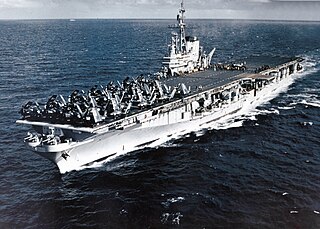
USS Midway (CVB/CVA/CV-41) is an aircraft carrier, formerly of the United States Navy, the lead ship of her class. Commissioned eight days after the end of World War II, Midway was the largest warship in the world until 1955, as well as the first U.S. aircraft carrier too big to transit the Panama Canal. She operated for 47 years, during which time she saw action in the Vietnam War and served as the Persian Gulf flagship in 1991's Operation Desert Storm. Decommissioned in 1992, she is now a museum ship at the USS Midway Museum, in San Diego, California, and is the only remaining inactive U.S. aircraft carrier that is not an Essex-class aircraft carrier.

USS Coral Sea (CV/CVB/CVA-43), a Midway-class aircraft carrier, was the third ship of the United States Navy to be named for the Battle of the Coral Sea. She earned the affectionate nickname "Ageless Warrior" through her long career. Initially classified as an aircraft carrier with hull classification symbol CV-43, the contract to build the ship was awarded to Newport News Shipbuilding of Newport News, Virginia, on 14 June 1943. She was reclassified as a "Large Aircraft Carrier" with hull classification symbol CVB-43 on 15 July 1943. Her keel was laid down on 10 July 1944 in Shipway 10. She was launched on 2 April 1946 sponsored by Mrs. Thomas C. Kinkaid and commissioned on 1 October 1947 with Captain A.P. Storrs III in command.

USS Joseph Strauss (DDG-16), named for Admiral Joseph Strauss USN (1861–1948), was a Charles F. Adams-class guided missile destroyer of the United States Navy.

USS Chicago (CA-136/CG-11) was a Baltimore-class heavy cruiser laid down on 28 July 1943 at Philadelphia, Pennsylvania, US, by the Philadelphia Navy Yard. Launched on 20 August 1944, she was sponsored by Mrs. Edward J. Kelly, wife of the Mayor of Chicago, Illinois, and commissioned at the Philadelphia Navy Yard on 10 January 1945, Captain Richard R. Hartung, USN, in command. She served in some of the last battles around the Japan home islands in WWII, and as part of the post war occupation fleet. Decommissioned after the war, she was refitted as a missile cruiser beginning in the late 1950s and recommissioned in 1964, serving during the Vietnam War. She served until 1980. USS Chicago CG-11 carried the title of "The World's Most Powerful Guided Missile Cruiser".

USS Newport News (CA–148) was the third and last ship of the Des Moines-class of heavy cruisers in the United States Navy. She was the first fully air-conditioned surface ship and the last active all-gun heavy cruiser in the United States Navy.

USS Oklahoma City (CL-91/CLG-5/CG-5) was one of 27 United States Navy Cleveland-class light cruisers completed during or shortly after World War II, and one of six to be converted to guided missile cruisers. She was the first US Navy ship to be named for Oklahoma City, Oklahoma. Commissioned in late 1944, she participated in the latter part of the Pacific War in anti-aircraft screening and shore bombardment roles, for which she earned two battle stars. She then served a brief stint with the occupation force. Like all but one of her sister ships, she was retired in the post-war defense cutbacks, becoming part of the Pacific Reserve Fleet in 1947.

Operation Linebacker was the codename of a U.S. Seventh Air Force and U.S. Navy Task Force 77 air interdiction campaign conducted against North Vietnam from 9 May to 23 October 1972, during the Vietnam War.

USS Fox (DLG-33/CG-33) was a Belknap class cruiser of the United States Navy, named after Gustavus V. Fox, President Abraham Lincoln's Assistant Secretary of the Navy. The keel for DLG-33 was authenticated and laid in ceremonies at Todd Shipyards, Los Angeles Division, San Pedro, California on 15 January 1963.

Strike Fighter Squadron 94 (VFA-94), also known as the Mighty Shrikes, is a United States Navy fighter squadron stationed at Naval Air Station Lemoore. It is an operational fleet squadron currently flying the F/A-18E Super Hornet. It is attached to Carrier Air Wing 17 and based at NAS Lemoore, California. Its tail code is "NA" and its radio call sign is "Hobo".

USS Wiltsie (DD-716) was a Gearing-class destroyer in the United States Navy. She was named for Irving Wiltsie. The destroyer entered service in 1946 and remained active with the United States Navy until 1977, when Wiltsie was decommissioned and sold to Pakistan in 1977. The vessel entered service with the Pakistan Navy as PNS Tariq (D165) in 1978. In 1990, the ship was renamed PNS Nazim to allow the name Tariq to be given to a newly-acquired Type 21 frigate. The ship was then transferred to the Pakistan Maritime Security Agency and used as an alongside "at sea" headquarters for the agency. Though afloat, the vessel no longer sails.

USS Hanson (DD/DDR-832) was a Gearing-class destroyer of the United States Navy named after first lieutenant Robert M. Hanson of the United States Marine Corps squadron VMF-215.
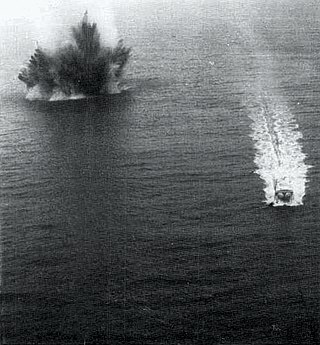
Operation End Sweep was a United States Navy and United States Marine Corps operation to remove naval mines from Haiphong harbor and other coastal and inland waterways in North Vietnam between February and July 1973. The operation fulfilled an American obligation under the Paris Peace Accord of January 1973, which ended direct American participation in the Vietnam War. It also was the first operational deployment of a U.S. Navy air mine countermeasures capability.

VA-52 was an Attack Squadron of the U.S. Navy. It was established as U.S. Navy Reserve Fighter Squadron VF-884 on 1 November 1949, and called to active duty on 20 July 1950. It was redesignated VF-144 on 4 February 1953, and VA-52 on 23 February 1959. The squadron was nicknamed the Bitter Birds from about 1951–1953, and the Knightriders from about 1960 onward. Its insignia evolved through several versions and variations from 1951 to the 1980s. VA-52 was decommissioned on 31 March 1995.
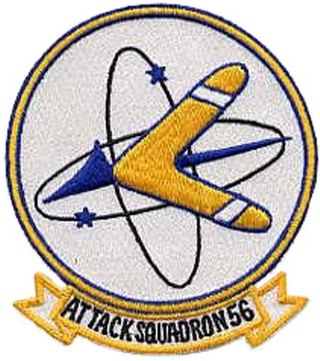
VA-56 was an Attack Squadron of the U.S. Navy. It was established on 4 June 1956, and disestablished thirty years later, on 31 August 1986. The squadron's nickname was the Boomerangs from 1957 to 1958, and the Champions thereafter.

Attack Squadron 196 (VA-196) was an aviation unit of the United States Navy. It was established as Fighter Squadron 153 (VF-153) on 15 July 1948, redesignated as VF-194 on 15 February 1950, and finally redesignated VA-196 on 4 May 1955. Its nicknames were the Thundercats from 1948 to the 1950s, and The Main Battery from the 1950s thereafter. Beginning in 1979 the squadron used the nickname Milestones interchangeably with Main Battery. The squadron was disestablished on 21 March 1997, after more than 48 years of service.
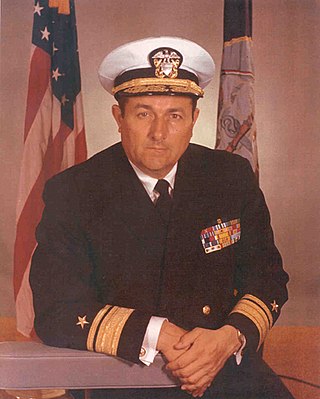
Rembrandt Cecil Robinson was a United States Navy officer who was stationed in the Tonkin Gulf during the Vietnam War. Robinson died in 1972, in a helicopter crash; he was the only Navy flag officer killed during the Vietnam War. His remains were cremated and the ashes were spread at sea from USS Orleck off San Diego, California. Robinson has a memorial cross in Arlington National Cemetery.
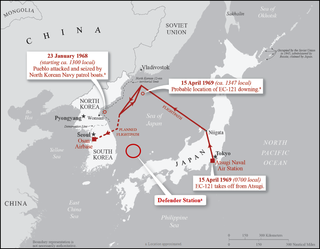
Operation Formation Star was the code name for the emergency re-deployment of U.S. Seventh Fleet warships to the Sea of Japan off the eastern coast of North Korea following that country's seizure of the USS Pueblo (AGER-2) in international waters on 23 January 1968.
Thomas William McNamara was a United States Navy officer who served in the Tonkin Gulf during the Vietnam War.



















